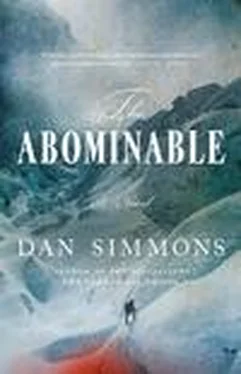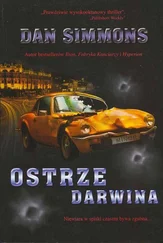Jean-Claude smiled, bent to his big bag, and pulled out a single, shiningly new metal crampon. It took me a few seconds to see the difference.
“It has front spikes…points,” I said at last. “Like horns.”
“Twelve-point crampons,” said Jean-Claude, his tone brisk and businesslike now. “The German ice climbers were talking about them. I had my father design and manufacture them.”
We all knew that Jean-Claude’s father had gone from being a blacksmith to running one of the biggest metal-pouring and forming companies in all of France, certainly in Chamonix. M. Clairoux Sr.’s business had grown by leaps and bounds thanks to French government (and some British and one American) contracts during the Great War. Now they produced everything from specialized steel pipelines to dental instruments.
“That looks dangerous,” I said.
“It is,” said Jean-Claude. “To the mountain that does not want to be climbed.”
“I think I understand,” said the Deacon, stepping forward to take the scary-looking 12-point crampon in his hand. “You kick these points in, put your weight on the solid, almost unbending shank of your new stiff boots, and use it as a platform. Even—theoretically—on near-vertical ice.”
“Oui,” said Jean-Claude. “But not just on ‘near-vertical,’ my friend. On sheer vertical. And worse than vertical. I have tested them in France. We shall test them here today.”
I confess that my heart started pounding rapidly. I’ve never enjoyed ice climbing. I hate surfaces where my boots can’t get a grip, however tenuous. J.C.’s “we shall test them here today” made my cold skin go clammy.
“There is more,” said Jean-Claude. “Show me your ice axes, my friends.”
We’d brought ours with us, of course. I pulled mine out of the snow and set it in front of me: long wood shaft and metal adze and pick on top. The Deacon retrieved his ice axe from the snow and leaned on it.
“How long is your ice axe, Jake?” asked J.C.
“Thirty-eight inches. I like that shorter length for cutting steps on a steep slope.”
“And yours, Richard?” Ree-shard.
“Forty-eight inches. It’s old-fashioned, I know. But so am I.”
Jean-Claude merely nodded. Then he reached into the bulging bag in the snow and brought out a series of “ice axes” that weren’t ice axes at all. The longest couldn’t have been much more than 20 inches or so in length. They were hammers, for God’s sake. Only with different adzes and picks atop each wooden or…dear Christ… steel shaft.
J.C.’s daddy had been busy at his steel-fitting plant.
“Your designs?” asked the Deacon, hefting one of these absurd hammer-things.
J.C. shrugged. “Based on what the Germans have been doing this year—you two told me so yourselves after you returned from Munich last November. So I climbed icy routes with them in Chamonix in December—with some young Germans, that is—saw their new techniques, used some of their new equipment. Then I made my own variations at l’usine de mon père to improve what they had.”
“Those aren’t ice axes!” I was almost spluttering.
“No?”
“No,” I said. “You couldn’t hike with any of those, couldn’t lean on them, couldn’t even cut ice steps on a steep slope.”
Jean-Claude held up one finger. “Au contraire,” he said softly, lifting one of the five short axe-hammer-things he’d left lying on the canvas bag. The one he was holding up looked most like a regular ice axe—wood shaft and all—but like a real ice axe that had been left out in the rain and shrunk by two-thirds. But instead of there being an adze on one side, as our ice axes had, the short end was as blunt as a hammer. It was a hammer.
“This ice hammer, my father and I call it ‘straight drooped,’” said J.C., “is superb for cutting steps on a steep ice or snow slope. And one does not have to lean out of balance as one would with either of our old longer ice axes.”
I just shook my head.
“The shortest one is there,” said the Deacon, pointing to a large hammer-sized thing made entirely of steel with a pointed and sort of threaded base and a long, flat pick on one side and very short adze on the other.
J.C. smiled and lifted it, then handed it to the Deacon, who took it in his free hand. “Light. Aluminum?”
“No, steel. But hollow in the shaft. This is what Father and I called the ‘technically curved’ short ice axe. For use on steep ice slopes, perfect for carving steps. This slightly longer one with the wooden handle, the one which looks more like a shortened version of a regular ice axe but with this long, curved, serrated pick, we called the ‘reverse curved’ axe. It is used”—he turned to the impossibly vertical ice wall behind him—“for that. ”
The Deacon had handed the two short ice axes to me and was rubbing his stubbled cheeks and chin. He hadn’t bothered to shave that morning, though we’d finally procured some hot water at that execrable inn.
“I’m beginning to see,” he said.
I was making axe-weapon downward swings with both sharp-picked…things. I imagined the long, curved picks penetrating a French skull.
“How did you find this place…Cwm Idwal?” asked the Deacon. He was craning backward to look up at the vertical ice cliff, now glistening wickedly in the late-morning sun. Its terrifying slab of rock and ice hung directly above us like a giant weight that could drop 200 feet onto us at any time. The overhang was just too broad and thick to free-climb—the width of rock twice Jean-Claude’s entire height, at least, and the slabs of ice extending another five or six feet. There would be no sane way to get to the vertical rock and ice above the overhang for the last icy pitch of eight feet or so.
“I asked British ice climbers for the best place in England and Wales,” responded Jean-Claude.
“There are British ice climbers?” asked the Deacon. I didn’t know if he was faking his tone of wonder and surprise. I’d always assumed that the Deacon personally knew all British climbers. And most of the French and German ones as well.
“A very few,” said J.C. with a small smile.
“What next?” asked the Deacon, pointing to the still mostly full bag, sounding eager to see the next weird thing to pop out.
Jean-Claude Clairoux turned around, stepped back, shielded his eyes, and joined the Deacon in looking up at the sheer ice wall and terrifying overhang. “Next,” he said, his voice almost lost in the rising breeze, “…next, all three of us climb that wall today. All of it. Including the overhang. To the top.”
All right, I’ll be honest. I would have pissed my silken underwear and new woolen knickerbockers at that moment if I hadn’t been sure it would have frozen into a long and very uncomfortable icicle.
“You…can… not… be…fucking…serious,” I said to my diminutive French ex-friend. It was only the second time in my life that I’d ever used that word and certainly the first time in the presence of my two new climbing partners.
J.C. smiled.
From the largest bag, J.C. had pulled out three sturdy but light leather…“harnesses” is the word that comes to mind—although there were metal carabiners on the front of the belt, where straps met in the center of the chest, and more loops and carabiners around the wide belt—and while the Deacon and I were tugging our harnesses on, dubiously, Jean-Claude simply lifted his left leg as high as it would go, kicked his new forward crampons of the 12-point set into the wall of ice, hammered in the pick end of both of his short ice axes—connected to his wrists, I noticed now, by short leather straps and loops—and pulled himself up until he was supporting himself just on that rigid left foot. His harness jingled because he was carrying a variety of self-designed steel implements on it—an extra ice tool of some sort set in its holster, a mass of shiny carabiners, a large bag of ice screws, other bags of jangly things set around his belt. A huge coil of rope was slung over his shoulder and across his chest, and now he slowly let it out beneath him as he started to climb.
Читать дальше












